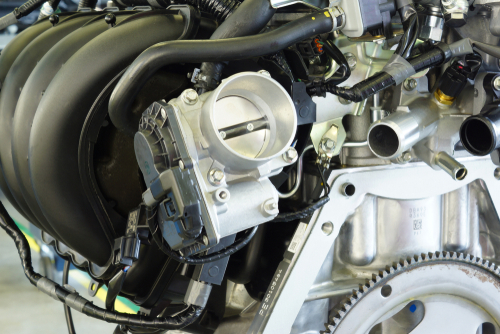Ever had your car sound like it’s trying to impersonate a jet engine? That might be your turbocharger acting up.
When you see the P0033 code pop up on your OBD-II scanner, it’s time to pay attention.This pesky code indicates a problem with your Turbocharger Bypass Valve Control Circuit, which can lead to reduced engine performance and efficiency.

You might notice your car lacking its usual pep or hear strange noises coming from under the hood.
Don’t worry, though – you’re not about to take off into the wild blue yonder. The P0033 code is your vehicle’s way of saying, “Hey, something’s not right with my turbo system!”
While it might sound intimidating, understanding this code is the first step to getting your ride back in tip-top shape.
So buckle up, and let’s dive into the world of turbochargers, bypass valves, and the mysterious P0033 code.
Trust me, by the end of this, you’ll be talking turbo like a pro at your next backyard barbecue.
Key Takeaways
- The P0033 code signals a Turbocharger Bypass Valve Control Circuit issue, potentially causing reduced engine performance.
- Common symptoms include whining noises, excessive exhaust smoke, and decreased power.
- Fixing the problem often involves inspecting and replacing the actuator or valve.
Understanding the Turbocharger
Hey there, gearhead! Ever wondered what that little whirling doodad under your hood is all about?
Well, buckle up, because we’re about to take a spin through the wild world of turbochargers!
A turbocharger is like a tiny tornado trapped in your engine. It spins faster than your ex running away with your credit card, using exhaust gases to force more air into the engine.
This extra air means more fuel can be burned, giving your ride a serious power boost.
Now, don’t confuse this bad boy with its cousin, the supercharger.
While both give your engine a kick in the pants, a turbo uses exhaust gases, while a supercharger is belt-driven. It’s like comparing a jet engine to a propeller – both’ll get you there, but one’s got a bit more oomph!
The turbocharger system is a delicate dance of pressure and precision. Too much boost pressure, and your engine might go boom faster than you can say “warranty void”.
That’s where the bypass valve comes in, acting like a pressure release valve for your turbo.
For optimal performance, your turbo needs to be in tip-top shape.
Think of it as the star athlete of your engine – it needs proper care and feeding to perform at its best. Regular oil changes and not thrashing it when cold are key to keeping your turbo happy.
Remember, a well-maintained turbocharger can turn your daily driver into a pocket rocket. So treat it right, and it’ll reward you with grins for miles!
Decoding P0033: The Trouble Behind the Code

Ah, the dreaded P0033 trouble code. It’s like that pesky neighbor who always complains about your lawn – annoying, but you can’t ignore it.
When your trusty steed’s check engine light starts flashing like a disco ball, it might be trying to tell you something important. In this case, it’s whispering (or shouting) “P0033” in car language.
This diagnostic trouble code (DTC) is all about your turbocharger’s bypass valve control circuit. Think of it as the bouncer for your engine’s VIP section, controlling who gets in and who doesn’t.
But what exactly does P0033 mean for you and your four-wheeled friend? Let’s break it down:
- Turbocharger issues: Your car’s turbo might be feeling under the weather
- Valve control problems: The bypass valve could be stuck in vacation mode
- Circuit malfunction: Electrical gremlins might be wreaking havoc
Remember, this fault code isn’t just a random number your car came up with while playing bingo. It’s a cry for help from your vehicle’s computerized brain.
So, next time your check engine light decides to put on a light show, don’t panic. It might just be good ol’ P0033 knocking on your dashboard. Time to roll up those sleeves and show your car some TLC!
Symptoms and Detection

When your turbocharger starts acting up, it’s like your car’s caught a cold. You’ll notice some telltale signs that something’s not quite right under the hood.
Recognizing the Symptoms
Is your trusty steed feeling a bit under the weather? The most obvious sign of P0033 is that pesky check engine light illuminating your dashboard like a Christmas tree. But that’s not all, folks!
You might feel like your car’s lost its mojo, with a noticeable drop in performance. It’s like trying to run a marathon with a pebble in your shoe – everything’s just a bit off.
Your engine might start misfiring, sputtering like it’s had one too many at the local watering hole.
And let’s not forget about power loss. Suddenly, your zippy little car feels more like a snail on roller skates. Hills that you used to conquer now feel like Mount Everest.
Diagnostic Tools and Methods
Now, don’t worry – you don’t need to be a rocket scientist to figure this out.
Your best friend in this detective work is going to be an OBD-II scanner. It’s like a crystal ball for your car, revealing all its deepest, darkest secrets.
Pop that bad boy into your car’s diagnostic port, and voila! It’ll spit out those diagnostic trouble codes faster than you can say “turbocharger”. The P0033 code will likely be front and center, waving its arms and screaming, “Look at me!”
But wait, there’s more!
A good scan tool can also show you real-time data. You can check boost pressure levels and see if they’re playing nice with what the manufacturer intended.
It’s like being a car whisperer, listening to what your vehicle is trying to tell you.
Root of the Issue: Common Causes

Ever wondered why your car’s throwing a P0033 tantrum? Let’s pop the hood and take a look at what’s causing this pesky turbocharger bypass valve control circuit issue.
First up, we’ve got the usual suspect – a faulty turbocharger bypass valve. This little gadget can wear out faster than your favorite pair of sneakers, causing all sorts of boost pressure shenanigans.
Next on our hit list: wiring issues. You’d be amazed how often a few frayed wires can throw your whole system out of whack. Keep an eye out for damaged wiring, corroded connectors, or loose connections.
Don’t forget about those sneaky vacuum leaks! Your turbo system relies on proper vacuum pressure, so any leaks in the lines can cause the P0033 code to pop up faster than a prairie dog.
Here’s a quick rundown of other common culprits:
- Faulty bypass valve solenoid
- Damaged actuator
- Corroded connectors
- Engine temperature sensor issues
Diagnosing these issues isn’t always a walk in the park. If you’re not comfortable poking around under the hood, it’s best to leave it to the pros. They’ve got the tools and know-how to get your turbo purring like a kitten in no time.
Fixing the Problem: Troubleshooting and Repairs
Got a pesky P0033 code? Don’t worry, we’ll get your turbo purring again. Let’s dive into the nitty-gritty of diagnosing and fixing that troublesome bypass valve control circuit.
Initial Troubleshooting Steps
First things first, grab your trusty OBD-II scanner and confirm that P0033 is indeed your culprit.
Now, pop the hood and give those electrical connections a once-over. Loose or corroded wires can be sneaky troublemakers.
Next, check for any visible vacuum leaks. A quick visual inspection of hoses and connections might save you hours of head-scratching later.
Don’t forget to test your boost pressure. If it’s lower than your car’s specs, you might have found your smoking gun.
Remember, a malfunctioning turbocharger bypass actuator is often the root cause of this code.
Advanced Diagnostic Procedures
Time to put on your detective hat!
Start by testing the resistance of your bypass valve solenoid. If it’s not within spec, you’ve likely found your culprit.
Next, break out the multimeter and check the voltage at the solenoid connector. No voltage? You might be dealing with a wiring issue or a faulty ECU.
For the truly adventurous, grab an oscilloscope and check the PWM signal from your PCM to the solenoid. Abnormal readings here could indicate a problem with your powertrain control module.
Don’t forget to check related sensors. A faulty boost pressure sensor or knock sensor can sometimes trigger this code.
Repair and Replacement Tips
If your bypass valve solenoid has given up the ghost, replacement is your best bet. It’s usually a straightforward job, but consult your vehicle’s manual for specific instructions.
Wiring issues? Start by cleaning all connections.
If that doesn’t do the trick, you might need to repair or replace the wiring harness.
For the brave souls tackling a turbocharger wastegate replacement, take your time and follow the manual to the letter. One misplaced bolt can lead to a world of hurt.
Remember, if you’re not comfortable with these repairs, there’s no shame in calling in a pro. The average repair cost for P0033 ranges from $150 to $400, depending on the specific issue and your vehicle model.
Frequently Asked Questions
Turbocharger bypass valve control circuit issues can be tricky to diagnose and fix. Let’s tackle some common questions about the P0033 code and related problems.
What signs indicate a malfunction in the turbo bypass valve control circuit?
You might notice your engine performance taking a nosedive.
Reduced power is a telltale sign. Listen for unusual whining or rattling from the turbo area.
Your exhaust might start smoking more than usual. If you’re seeing these symptoms, it’s time to dig deeper.
How can I diagnose issues with the turbocharger bypass valve control circuit?
First things first, grab your trusty OBD2 scanner. It’ll help you confirm that P0033 code.
Next, give your turbo a once-over.
Check those vacuum lines for any damage.
Don’t forget to test the boost pressure levels. A multimeter can be your best friend when checking the circuit’s voltage.
Could a P0033 code signify problems beyond the turbocharger bypass valve control circuit?
You bet it could! While the bypass valve is often the culprit, don’t rule out other suspects.
Faulty wiring or connectors can throw this code too.
Sometimes, it’s the PCM playing tricks on you. In rare cases, internal engine issues might be masquerading as a P0033.
What steps should I take if I get a P0033 code on my Ford Focus?
First, don’t panic! Start by checking those vacuum lines. Ford Focuses can be finicky with their turbo systems.
Inspect the bypass valve itself. If it’s stuck, you might need to replace it.
Don’t forget to clear the code and test drive to see if it comes back.
Are there common failures with the turbocharger bypass valve control circuit in Chevys?
Chevy fans, listen up! Your turbos can be troublemakers too.
Many Chevy models are prone to wastegate actuator failures.
Check for loose connections or corroded wires. Sometimes, it’s as simple as a bad ground causing all the fuss.
What maintenance tips can help prevent turbocharger bypass valve control circuit issues?
Regular oil changes are your turbo’s best friend. Use the right grade oil, and your turbo will thank you.
Keep an eye on those boost pressure levels.
Don’t ignore strange noises or performance changes. Catching issues early can save you from bigger headaches down the road.
And remember, let your engine warm up before you go full throttle!
